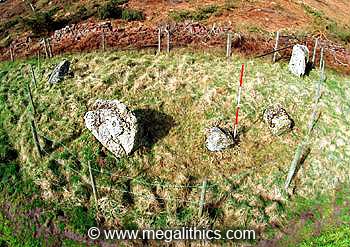
 |
Photo Gallery |
|
Panoramas |
||
Infrared |
||
| NY 56309 26295 (GPS 17min). | Diameter 10.1m (Meas. best fit to visible stones) |
| Visited - April 2003 | No magnetic anomalies |
The Leacet Hill circle stands on the edge of a plantation about 6km SE of Penrith. Described on the 1:50000 OS map as a "Cairn Circle", Leacet is not the usual contiguous ring of low slabs placed lengthwise around a central cairn. The stones stand upright, some of them relatively tall, and they have the wide regular spacing associated with true free-standing stone circles. There is a central flat-topped cairn and the stones are arranged around the edges of this.
At first sight it appears that what remains
at the site today is only half of a stone circle, the surviving semicircle of
stones standing on one side of a drystone wall. Presently, the land to the north
of the wall is used for forestry, the ground rising steeply from the projected
northern edge of the circle up to the top of Leacet Hill itself. The land to the
south of the circle is flat for some distance, it almost seemed as though the
circle were nestling at the base of the hill, as if for shelter.
We found five stones, three of them sizable, with the tallest standing 1.75m
high at the east. It has been suggested that the stone at the south (base of
pole in above photo), is not an original circle stone, this is probably because its
position disturbs the regular c4m spacing seen with the other stones. We
plotted the position of the five visible stones (including the southern), and
obtained a best-fit circle of 10.1m.
According to published reports and an excavation (1) carried out in 1880, the
circle originally had nine stones and although some are fallen, all are still
supposed to be in situ. Three stones of between 1.2m and 0.8m are said to lie
buried on the north side of the wall and two stones 50cm high are said to stand
between the wall and the visible western and eastern stones. We certainly could
not find the two small stones and if the c4m spacing holds true, the eastern
stone would be on the north side of the wall, not the south. The circle area on
the north of the wall was deeply buried in forestry debris from recent logging,
with at least one tree stump intruding into the circle, so it was impossible to
tell if the three large stones still lie buried there.
The excavation revealed cremation deposits at the base of four of the stones
accompanied by five collared urns, a pygmy cup and a food vessel. At the centre
of the cairn was a layer of charcoal containing calcined bone and fire-reddened
stones, the circle diameter was quoted as being 10.1m x 11.3m.
(1) Robinson & Ferguson 1881, Trans. Cumberland & Westmorland Arch. Soc. 5, 75